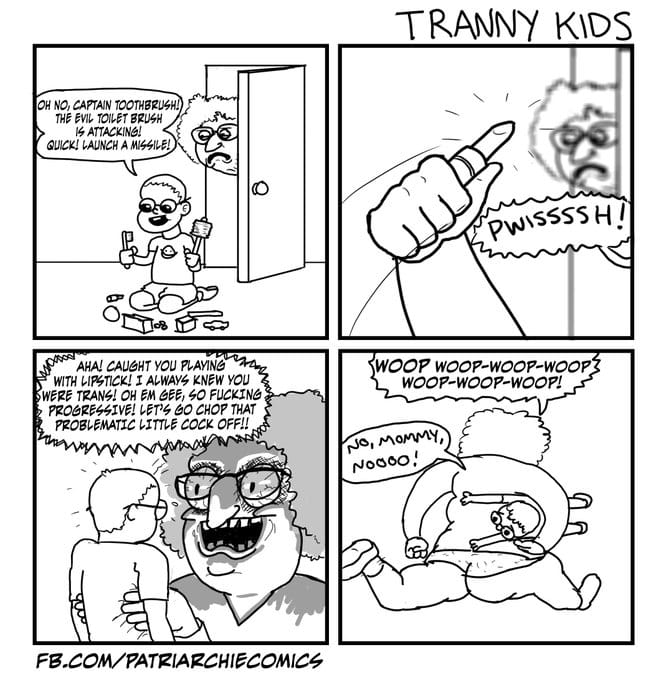There’s a great deal of truth in the saying that “a trans child is like a vegan cat”. You can tell who’s really making the choices, in this state of affairs. It’s certainly not the cat, and, all too often, it’s not the child, either.
When confronted with a child with “gender dysphoria”, we know that the “affirmation model” is busted. The first resort ought not to be puberty blockers and surgical mutilation, but rigorous psychological assessment. Psychological assessment that ought to take a good look at the adults in the child’s life — whether that’s sleazy “gender whisperers” at school or online, or the parents.
Very early on, the psychological literature indicated that the opposite-sex parent relationship was a strong factor in “gender dysphoria”. Fathers who wanted a boy to throw ball with, perhaps, or mothers who really wanted a little girl to dress up and paint their nails.
A new study has found that, in the case of boys with “Gender Identity Disorder”, a disproportionate number of their mothers are clingy madwomen.
Fifty-three percent of the mothers of boys with GID compared with only 6% of controls met the diagnosis for Borderline Personality Disorder on the Diagnostic Interview for Borderlines or had symptoms of depression on the Beck Depression Inventory. Results of the Summers and Walsh Symbiosis Scale suggested that mothers of probands had child-rearing attitudes and practices that encouraged symbiosis and discouraged the development of autonomy.
So, mothers of “trans” boys are nearly nine times as likely to be mentally ill, with apron strings pulled strangling tight. It rubs off on their unfortunate offspring.
It is now fairly well established that GID usually occurs in a context of psychopathology other than cross-gender behavior. For example, studies have found that extremely feminine boys have more psychopathology than normal […] On blind rated Rorschachs, boys with GID, when compared with normal controls, were found to have more evidence of boundary disturbances and a more frequent internal experience of others as overpowering and malevolent.
Journal of the American Academy of Child & Adolescent Psychiatry
Anecdotally, we see such behaviour exhibited by the likes of the mother of a teenage de-transitioner, “Lucas”. When Lucas was eight, his parents acrimoniously split. After spiriting him overseas, his mother isolated him from school for years and fed him a man-hating narrative. Soon, she was dressing him in girl’s clothing and forcing him to binge-watch RuPaul’s Drag Race. When his mother allowed him back to school, Lucas’ teachers doted on their “trans” student.
“I was a star, or least I felt like it. The teachers absolutely adored me and used me as an example all the time. I got special treatment. I could never do any wrong […] According to Lucas his mother was enjoying the attention just as much as he was. She’d be invited to special events to talk about ‘raising trans kids’ and things like that.
PopTopic
For many of these boys, as for any boy, their mother is an adored figure. So, tragically, they turn their resentment inward.
Boys with GID exhibit chronic suffering that is often expressed directly by them as self-hate. One boy at age three said: “I hate myself. I don’t want to be me. I want to be somebody else. I want to be a girl.”
Just as the owners of vegan cats are projecting their own peculiarities onto their unfortunate pets, many mothers of “trans” boys are using their suffering sons as proxy dress-up dollies.

The findings of the Symbiosis Interview suggest that mothers of boys with GID have child-rearing attitudes and behavior that promote symbiosis and interfere with the de velopment of autonomy. Compared to the control group, mothers of sons with GID are extremely dependent on their sons for emotional sustenance. They have boundary problems and difficulty separating from their sons. They use intrusive control measures when limit setting and disapprove of their sons’ relationships with others […]
From previous observations, the authors believe that cross gender identification in the majority of boys, but not in all, is a defensive solution to separation anxiety.
Journal of the American Academy of Child & Adolescent Psychiatry
So, where does this leave the recent, astonishing surge in girls “identifying as” boys? Perhaps we ought to similarly look at paternal relationships, but evidence would suggest otherwise. It’s notable that “trans men” have previously been extremely rare. “Gender dsyphoria” was, until just a few years ago, an almost exclusively male problem.
Yet, in just five years, this has been turned on its head. More notably, “trans” among girls occurs in clusters. If one girl “identifies as a boy”, others suddenly appear. This suggests another dynamic at work. Most likely, teen girls being the born faddists that they are, social contagion is the most likely answer. No less than outbreaks of anorexia, self-harm and suicide attempts.
The only difference is that no one treats self-harm by handing out packets of razor blades.









